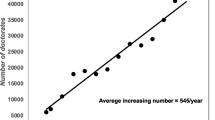Abstract
After presenting arguments that the number of highly cited papers (HCPs, 25 or more citations) has some advantages as an indicator of an author's scientific impact, the paper discusses citation data of 338 university professors in departments of medicine in the Netherlands. An analysis of the distribution of HCPs over the years provides support for the following conclusions: (1) prolific researchers with a large number of HCPs usually manifest themselves already in their Ph.D. work, apparently almost independent of the scientific setting; (2) it cannot be taken for granted that a successful Ph.D. student with some HCPs connected with his/her doctoral thesis will become a prolific successful researcher; (3) it is unlikely that an unsuccessful Ph.D. student without HCPs connected with his/her doctoral thesis will turn out to be a prolific successful researcher; and (4) for researchers, just as for artists, sportsmen, etc., talent is the most decisive factor in being successful.
Similar content being viewed by others
References
S. Cole, J.R. Cole, Scientific output and recognition: A study in the operation of the reward system in science,American Sociological Review, 32 (1967) 377–390.
G. Folly, B. Hajtman, J.I. Nagy, I. Ruff, Some methodological problems in ranking scientists by citation analysis,Scientometrics, 3 (1981) 135–147.
S.M. Lawani, A.E. Bayer, Validity of citation criteria for assessing the influence of scientific publications: New evidence with peer assessment,Journal of the American Society for Information Science 34 (1983) 59–66.
B.R. Martin, J. Irvine, Assessing basic research: Some partial indicators of scientific progress in radio astronomy,Research Policy, 12 (1983) 61–90.
H. Rigter, Evaluation of performance of health research in the Netherlands,Research Policy, 15 (1986) 33–48.
J.A. Virgo, A statistical procedure for evaluating the importance of scientific papers,Library Quarterly, 47 (1977) 415–430.
E. Garfield, The 100 most-cited papers ever and how we select citation classics,Current Contents, 27, June 4 (1984) 3–9.
E. Garfield, The articles most-cited in 1961–1982. 2. Another 100 citation classics highlight the technology of science,Current Contents, 27, July 16(1984) 3–12.
E. Garfield, The articles most-cited in 1961–1982. 3. Another 100 all-time citation classics,Current Contents, 27, August 27 (1984) 3–9.
E. Garfield, The number of biochemical articles is growing, but why also the number of references per article?Current Contents, 23, March 17 (1980) 3–14.
E. Garfield, Journal citation studies. 43. Astrosciences journals — What they cite and what cites them,Current Contents, 27 (1984) 3–14.
R. Plomp, Statistical reliability of citation frequency as an indicator of scientific impact,Scientometrics, 17 (1989) 71–81.
R.K. Merton, The Matthew effect in science,Science, 159 (1968) 56–63. Reprinted in:R.K. Merton,The Sociology of Science, The University of Chicago Press, Chicago, 1973, pp. 439–459.
D.K. Simonton,Genius, Creativity, and Leadership. Harvard University Press, Cambridge, Mass. 1984, pp. 86–88.
E. Garfield, The 1,000 contemporary scientists most-cited 1965–1978. Part I. The basic list and introduction,Current Contents, 24, October 12 (1981) 3–12.
D.J. De Solla Price,Little Science, Big Science, Columbia University Press, New York, 1963.
S.D. Haitun, Stationary scientometric distributions. Part II. Non-Gaussian nature of scientific activities,Scientometrics, 4 (1982) 89–104.
B.F. Reskin, Scientific productivity and the reward structure of science,American Sociological Review, 42 (1977) 491–504.
J.S. Long, R. McGinnis, The effects of the mentor on the academic career,Scientometrics, 7 (1985) 255–280.
J.R. Cole, S. Cole,Social Stratification in Science, The University of Chicago Press, Chicago, 1973, p. 368.
C.A. Campbell, M.B.M. Campbell, The validity of the Roy approxiation for citation analysis,Scientometrics, 4 (1982) 411–416.
R. Roy, N.R. Roy, G.G. Johnson Jr., Approximating total citation counts from first author counts and from total papers,Scientometrics, 5 (1983) 117–124.
A.M. Diamond, Jr., The life-cycle research productivity of mathematicians and scientists,Journal of Gerontology, 41 (1986) 520–525.
A. Van Heeringen, P. A. Dijkwel, The relationship between age, mobility and scientific productivity. Part II. Effect of age on productivity,Scientometrics, 11 (1987) 281–293.
S. Cole, Age and scientific performance,American Journal of Sociology, 84 (1979) 958–977.
H.A. Abt, At what ages did outstanding American astronomers publish their most-cited papers?,Publications of the Astronomical Society of the Pacific, 95 (1983) 113–116.
D.B. Herrmann, How old were the authors of significant research in twentieth century astronomy at the time of their greatest achievements?,Scientometrics, 13 (1988) 135–137.
R.L. Helmreich, J.T. Spence, W.L. Thorbecke, On the stability of productivity and recognition,Personality and Social Psychology Bulletin, 7 (1981) 516–522.
A.J. Nederhof, A.F.J. Van Raan, Peer review and bibliometric indicators of scientific performance: A comparison of cum laude doctorates with ordinary doctorates in physics,Scientometrics, 11 (1987) 333–350.
Author information
Authors and Affiliations
Rights and permissions
About this article
Cite this article
Plomp, R. The significance of the number of highly cited papers as an indicator of scientific prolificacy. Scientometrics 19, 185–197 (1990). https://doi.org/10.1007/BF02095346
Received:
Issue Date:
DOI: https://doi.org/10.1007/BF02095346




